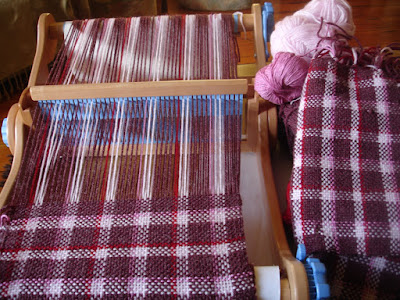The Power Scour vs washing-up-liquid project was on hold temporarily while my drum carder was out on loan. After diplomatically hinting for its return, it seems that it has a new owner as it was a cheque that came back instead, so that meant a shiny new one for me.
I should declare an interest in that I do
sell Power Scour in my shop (didn't get freebies, I still had to pay for it) but I did set out on this experiment feeling a bit sceptical.

I originally gave each sample a single wash as per my normal routine, but they've now had a second wash because I was waiting for my carder and because I wanted to see whether it would help to show up any differences.
The most obvious difference now is the smell. I didn't need to bury my face in the bag this time; as soon as I started to work with the Power Scoured fleece, the gorgeous smell was wafting around.
I've spent all day carding and spinning this fleece. I treated both halves the same - teased out the locks a little and flicked the ends with a comb before running it through the carder three times.
I did notice a difference in the carding; the Power Scoured locks were noticably fluffier and bouncier in my hands, the batts sometimes felt as well-separated after the second time as the washing-up detergent batch had after the third time. I thought it pulled out into sliver more easily. I put this all down to more effective removal of the grease. This is interesting because I know some people prefer to spin 'in the grease'. I have never washed grease out so thoroughly before, but I love the feel of today's fibre, and enjoyed spinning it, so I'll certainly scour more thoroughly in future.
No surprise to find that each batch of finished nests weigh the same, give or take a gram or two (around 105g per batch from the original 200g of raw fleece.) (I had to throw away a little second cut from each batch.) And I was left with exactly the same sized handful of dirt underneath the carder for each batch.

It has taken me most of the day to card and spin. Although I did think that the Power Scour batch drafted more readily, there's no difference in the look and feel of the finished plied yarn of course.
So today I've had the chance to spend lots of time getting to know my new (to me) Haldane. I bought it to re-sell but I have decided to keep it because I like it so much. As you can see, it's double-drive which is taking a little bit of getting used to, but it's far easier to use than I'd been led to believe.

I now have just over 200g of undyed creamy-white 2-ply. I was going to continue the experiment by knitting each half, but I think that's pointless. I'm listening to the two skeins, which are telling me that they're a blank canvas for some hand-painting...






















































